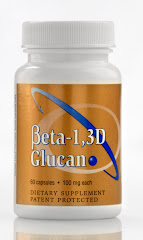What is Beta 1, 3-D Glucan?
Beta 1, 3-D Glucan from Baker's Yeast (Saccharomyces cerevisiae) is a pharmacological agent that enhances resistance to infection. Beta glucan has been shown to act through stimulation of immune cells. (Tsukagoshi, S. et al. 1984).
Glucans are long chain polysaccharide (sugar) molecules. Polysaccharides represent a structurally diverse class of macromolecules and have a high capacity for carrying biological information because of their great structural variability (like DNA).
Polysaccharides can interconnect at various points to form a wide range of branched or liner structures.
In nature there are many forms of these glucans.
Beta glucan is many glucose molecules joined in a specific way with branches called beta 1,3 linkages. These molecules have been shown to have specific stimulatory effects on the immune system. source
Showing posts with label Long Chain Polysaccharide. Show all posts
Showing posts with label Long Chain Polysaccharide. Show all posts
Tuesday, May 31, 2011
Sunday, September 13, 2009
How Much Transfer Point Beta Glucan Should I Take?
How much Transfer Point Beta-1, 3D Glucan should I take?
That depends on your immune system*, what you are dealing with, and your body weight. Everyone's immune system is different. Your immune system is also changing constantly. The information below will give you some guidance.
Current research suggests an effective dosage to range from 2mg-25mg of Beta Glucan per kilogram(kg) of weight. Depending on your current situation, you may benefit taking more or less of a daily dose.
To find your optimum dose, first convert pounds to kilograms (2.2 lbs. = 1 kg). For example, if you weighed 220 lbs., then you would weigh 100kg. This means you would want to take at least 200mg of Beta Glucan everyday, but no more than 2500mg everyday (research shows if you were to take more than 25mg per kilogram, there would be no added benefit).
*Remember, it is your immune system, not Beta Glucan that addresses any problems.
To maximize your uptake of the Transfer Point Beta-1, 3D Glucan, you should always take it on an empty stomach. Wait at least 30 minutes before eating or drinking anything. A small amount of pure water should be used to swallow the material. (No coffee, tea, juice, etc.)
Normally, simple sugars would be broken down in the digestive system, converted to glucose, and used for energy. This does not occur with a long chain polysaccharide like Beta-1,3D Glucan. The polysaccharide is carried across the lining of the small intestine into the lymphatic system. It is lined with enterones and enterocytes. They produce a sticky substance on their surface called glycocalix or “the fuzz”. In this glycocalix, binding sites (receptors) sit ready to grab the Beta-1,3D Glucan. From the lymphatic system, the Beta-1,3D Glucan is carried into the blood stream. This process is called endocytosis or pinocytosis. – A.J. Lanigan, Formulator Transfer Point Beta-1,3D Glucan
That depends on your immune system*, what you are dealing with, and your body weight. Everyone's immune system is different. Your immune system is also changing constantly. The information below will give you some guidance.
Current research suggests an effective dosage to range from 2mg-25mg of Beta Glucan per kilogram(kg) of weight. Depending on your current situation, you may benefit taking more or less of a daily dose.
To find your optimum dose, first convert pounds to kilograms (2.2 lbs. = 1 kg). For example, if you weighed 220 lbs., then you would weigh 100kg. This means you would want to take at least 200mg of Beta Glucan everyday, but no more than 2500mg everyday (research shows if you were to take more than 25mg per kilogram, there would be no added benefit).
*Remember, it is your immune system, not Beta Glucan that addresses any problems.
To maximize your uptake of the Transfer Point Beta-1, 3D Glucan, you should always take it on an empty stomach. Wait at least 30 minutes before eating or drinking anything. A small amount of pure water should be used to swallow the material. (No coffee, tea, juice, etc.)
Normally, simple sugars would be broken down in the digestive system, converted to glucose, and used for energy. This does not occur with a long chain polysaccharide like Beta-1,3D Glucan. The polysaccharide is carried across the lining of the small intestine into the lymphatic system. It is lined with enterones and enterocytes. They produce a sticky substance on their surface called glycocalix or “the fuzz”. In this glycocalix, binding sites (receptors) sit ready to grab the Beta-1,3D Glucan. From the lymphatic system, the Beta-1,3D Glucan is carried into the blood stream. This process is called endocytosis or pinocytosis. – A.J. Lanigan, Formulator Transfer Point Beta-1,3D Glucan
Subscribe to:
Posts (Atom)




